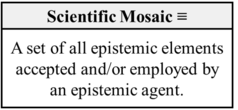Scientific Mosaic
What is scientific mosaic? How should it be defined?
Scientific mosaic is one of the key concepts in current scientonomy. Thus, its proper definition is of great importance.
In the scientonomic context, this term was first used by Hakob Barseghyan in 2015. The term is currently accepted by Scientonomy community.
In Scientonomy, the accepted definition of the term is:
- A set of all epistemic elements accepted and/or employed by an epistemic agent.
Contents
Scientonomic History
Acceptance Record
| Community | Accepted From | Acceptance Indicators | Still Accepted | Accepted Until | Rejection Indicators |
|---|---|---|---|---|---|
| Scientonomy | 1 January 2016 | This is when the community accepted its first definition of the term, Scientific Mosaic (2015), which indicates that the question is itself considered legitimate. | Yes |
All Theories
| Theory | Formulation | Formulated In |
|---|---|---|
| Scientific Mosaic (Barseghyan-2015) | A set of all accepted theories and employed methods. | 2015 |
| Scientific Mosaic (Barseghyan-2018) | A set of all epistemic elements accepted and/or employed by an epistemic agent. | 2018 |
| Scientific Mosaic (Rawleigh-2022) | A model of all epistemic elements accepted or employed by the epistemic agent. | 2022 |
Accepted Theories
| Community | Theory | Accepted From | Accepted Until |
|---|---|---|---|
| Scientonomy | Scientific Mosaic (Barseghyan-2015) | 1 January 2016 | 17 May 2020 |
| Scientonomy | Scientific Mosaic (Barseghyan-2018) | 17 May 2020 |
Suggested Modifications
| Modification | Community | Date Suggested | Summary | Verdict | Verdict Rationale | Date Assessed |
|---|---|---|---|---|---|---|
| Sciento-2018-0009 | Scientonomy | 8 October 2018 | Accept the new definition of scientific mosaic as a set of all epistemic elements accepted and/or employed by the epistemic agent. | Accepted | Initially, the modification raised an objection from Patton who argued that the modification "is not acceptable at present, because it contains a term; epistemic agent, which has not yet been defined within scientonomy".c1 This objection received two counterarguments. According to Barseghyan, the lack of such a definition of epistemic agent should not "be taken as a reason for postponing the acceptance of the definition of scientific mosaic", since inevitably any taxonomy contains terms that "rely in their definitions on other (yet) undefined terms".c2 This point was seconded by Rawleigh who argued that the definition of scientific mosaic is to be accepted regardless of whether there is an accepted definition of epistemic agent, since "it's de facto accepted already that some agent is required to have a mosaic".c3 In early 2020, Patton dropped his objection as he found that there was "sufficient general understanding of what an epistemic agent is to accept this definition of the scientific mosaic, even without first accepting a definition of epistemic agent".c4 Additionally, Rawleigh argued that the definition is to be accepted since we have "already accepted the revised question-theory ontology".c5 | 17 May 2020 |
| Sciento-2022-0001 | Scientonomy | 28 February 2022 | Accept a new model-theoretic definition of scientific mosaic, according to which, a scientific mosaic is a model of all epistemic elements accepted or employed by the epistemic agent. | Open |
Current Definition
In Scientonomy, the accepted definition of the term is Scientific Mosaic (Barseghyan-2018).
Scientific Mosaic (Barseghyan-2018) states: "A set of all epistemic elements accepted and/or employed by an epistemic agent."
According to this definition, scientific mosaic encompasses all accepted and employed epistemic elements. The definition is compatible with the ontology of epistemic elements that considers questions and theories (including methods as a sub-type of normative theories) as the only two fundamental types of epistemic elements. In addition, by not referring to any epistemic element explicitly, the definition also purports to be compatible with any future ontology of epistemic elements insofar as that ontology assumes that elements can be accepted and employed.
Ontology
Existence
In Scientonomy, there are currently no accepted claims concerning the existence of Scientific Mosaic.
Disjointness
In Scientonomy, no classes are currently accepted as disjoint with Scientific Mosaic.
Subtypes
In Scientonomy, there are currently no accepted subtypes of Scientific Mosaic.
Supertypes
In Scientonomy, there are currently no accepted supertypes of Scientific Mosaic.
Associations
In Scientonomy, there are currently no accepted associations of Scientific Mosaic.
If a question concerning the ontology of a scientific mosaic is missing, please add it here.
Dynamics
If a question concerning the dynamics of a scientific mosaic is missing, please add it here.
Related Topics
This term is also related to the following topic(s):
References
- ^ Bird, Alexander. (2011) Thomas Kuhn. In Zalta (Ed.) (2016). Retrieved from http://plato.stanford.edu/archives/sum2016/entries/thomas-kuhn/.
- ^ Kuhn (1962)
- ^ Lakatos, Imre. (1978) Philosophical Papers: Volume 1. The Methodology of Scientific Research Programmes. Cambridge University Press.
- ^ Matheson, Carl and Dallmann, Justin. (2015) Historicist Theories of Scientific Rationality. In Zalta (Ed.) (2016). Retrieved from http://plato.stanford.edu/archives/sum2016/entries/rationality-historicist/.
- a b c Laudan, Larry. (1984) Science and Values. University of California Press.
- ^ DeWitt, Richard. (2010) An Introduction to the History and Philosophy of Science. Wiley-Blackwell.
- ^ Preston, John. (2016) Paul Feyerabend. In Zalta (Ed.) (2016). Retrieved from http://plato.stanford.edu/archives/sum2016/entries/feyerabend/.
- ^ Feyerabend, Paul. (1975) Against Method. New Left Books.
- ^ Worrall, John. (1988) Review: The Value of a Fixed Methodology. The British Journal for the Philosophy of Science 39, 263-275.
- ^ Laudan (1989)
- ^ Worrall, John. (1989) Fix It and Be Damned: A Reply to Laudan. The British Journal for the Philosophy of Science 40, 376-388.
- a b c d e Barseghyan, Hakob. (2015) The Laws of Scientific Change. Springer.
- ^ Sebastien, Zoe. (2016) The Status of Normative Propositions in the Theory of Scientific Change. Scientonomy 1, 1-9. Retrieved from https://www.scientojournal.com/index.php/scientonomy/article/view/26947.
